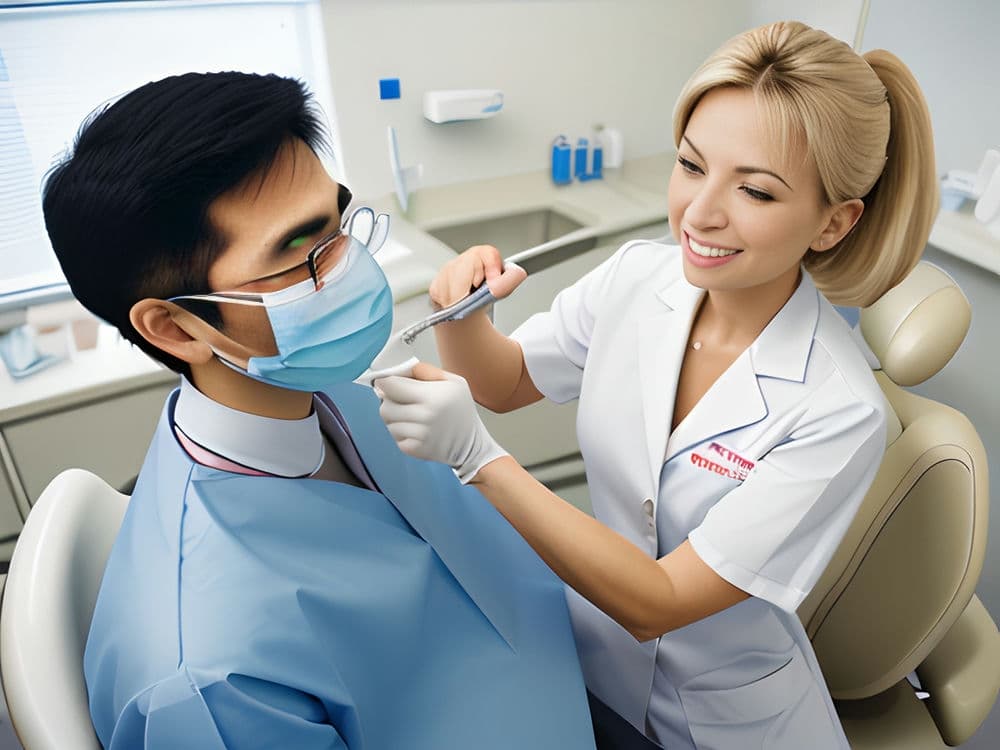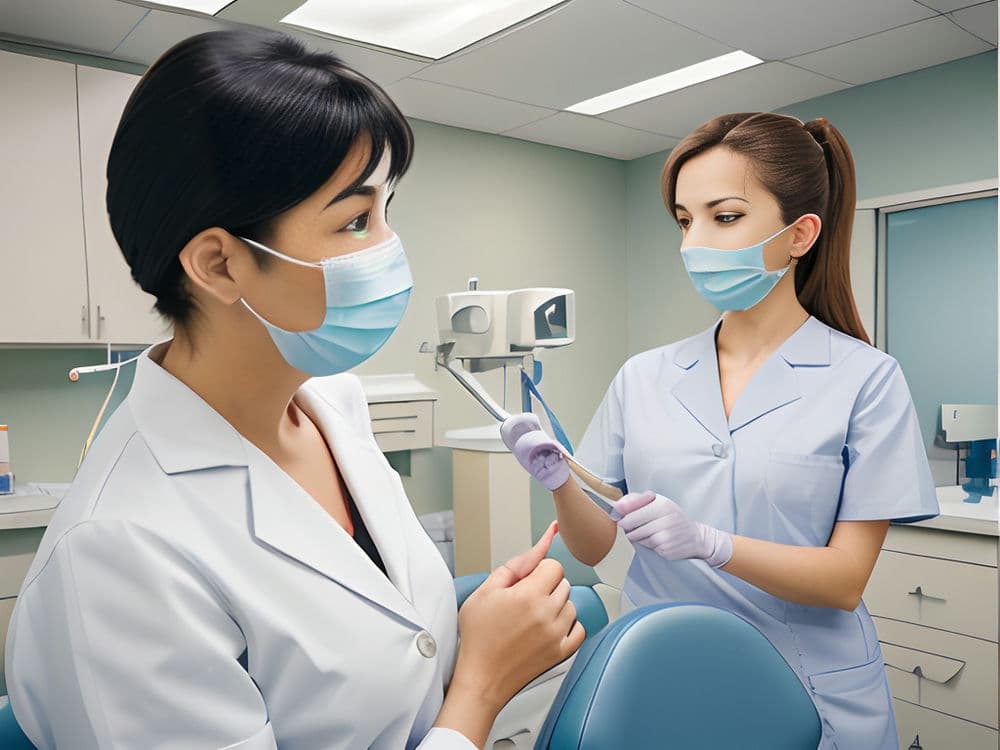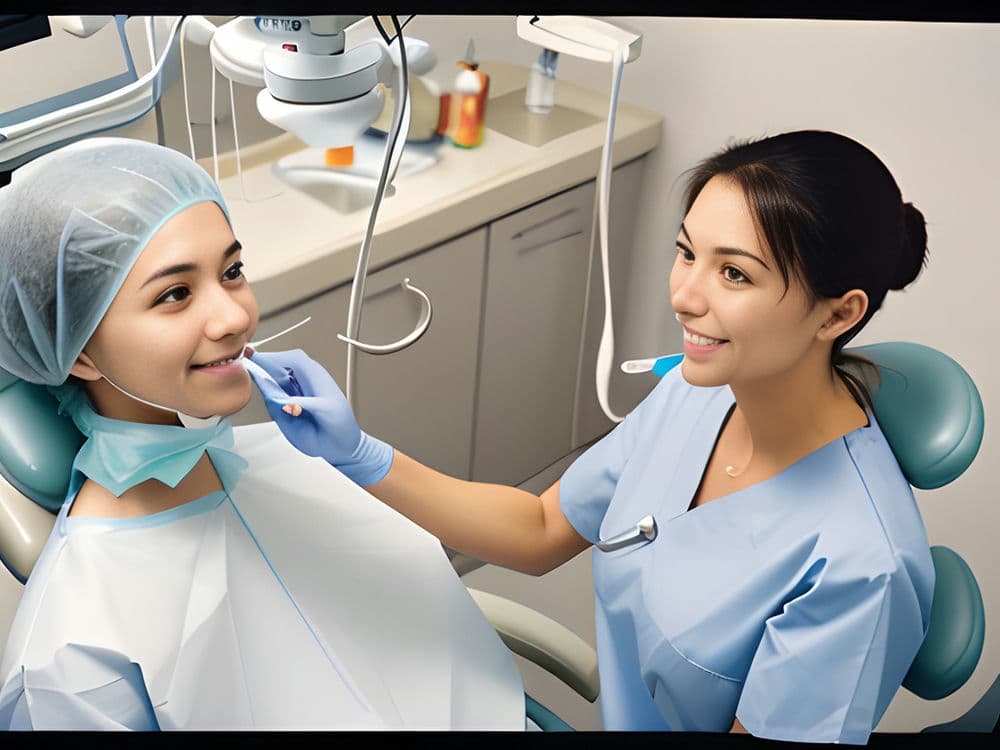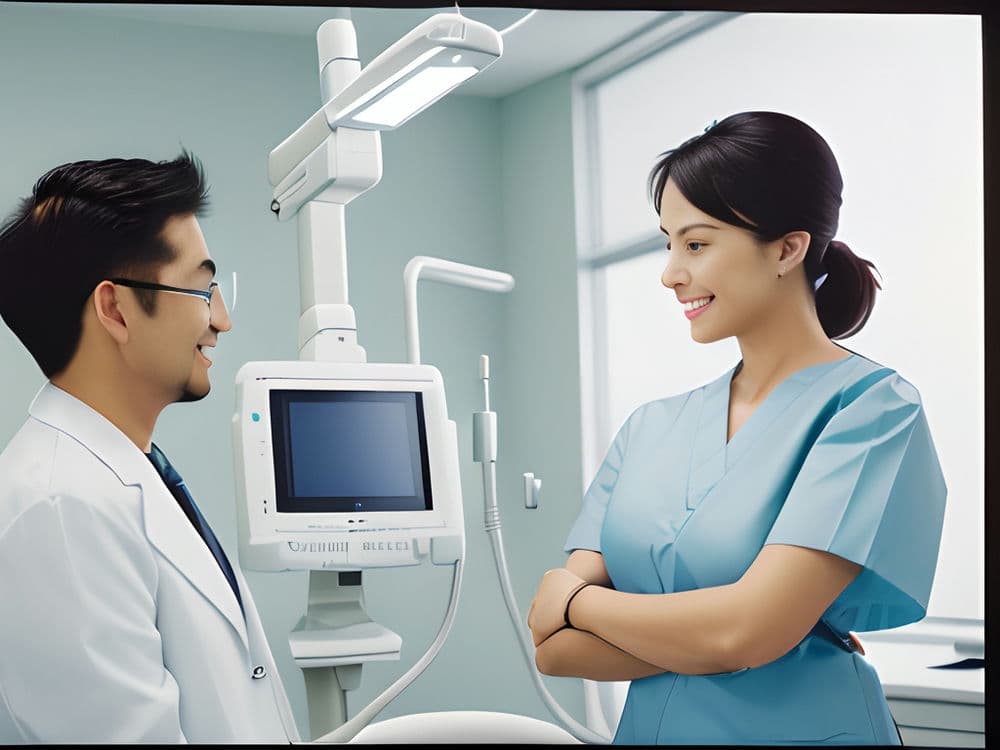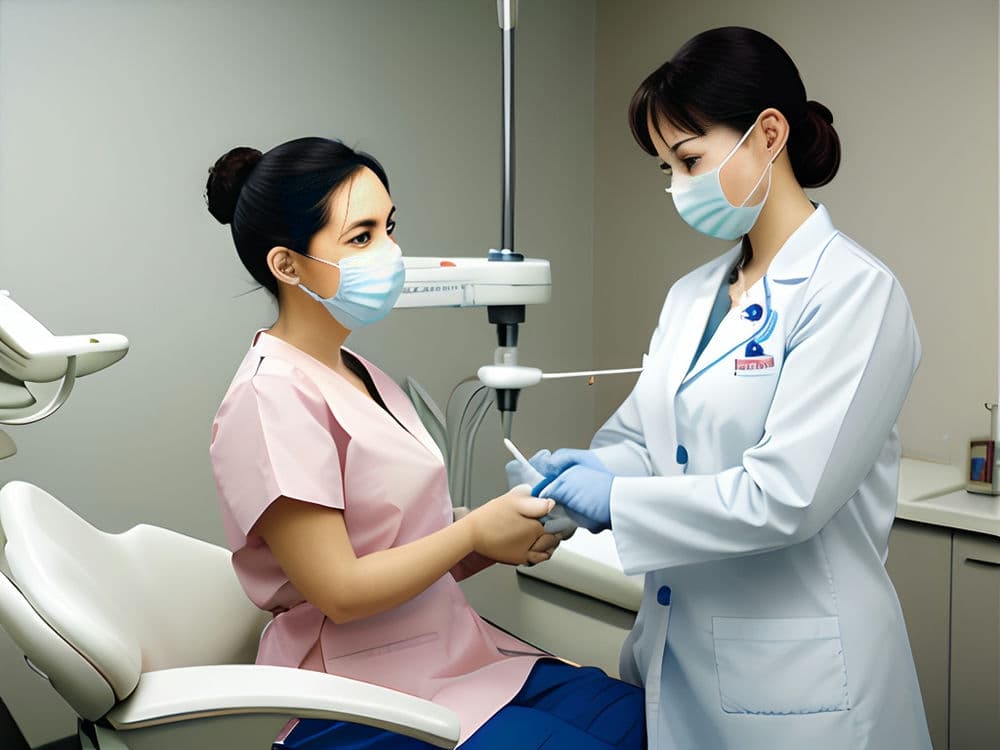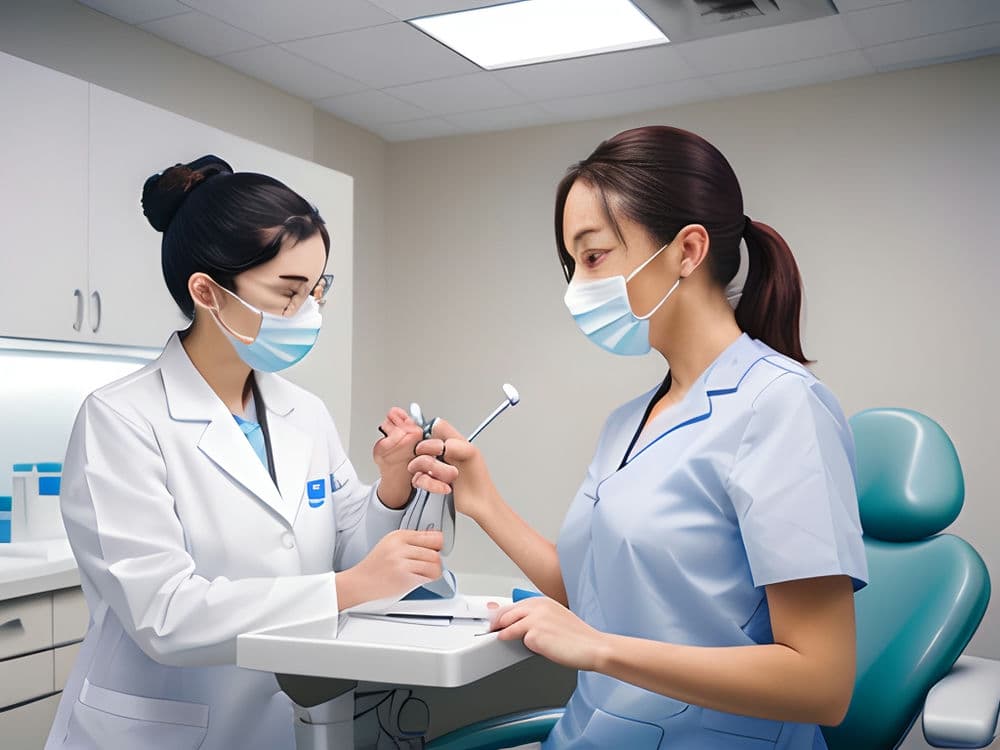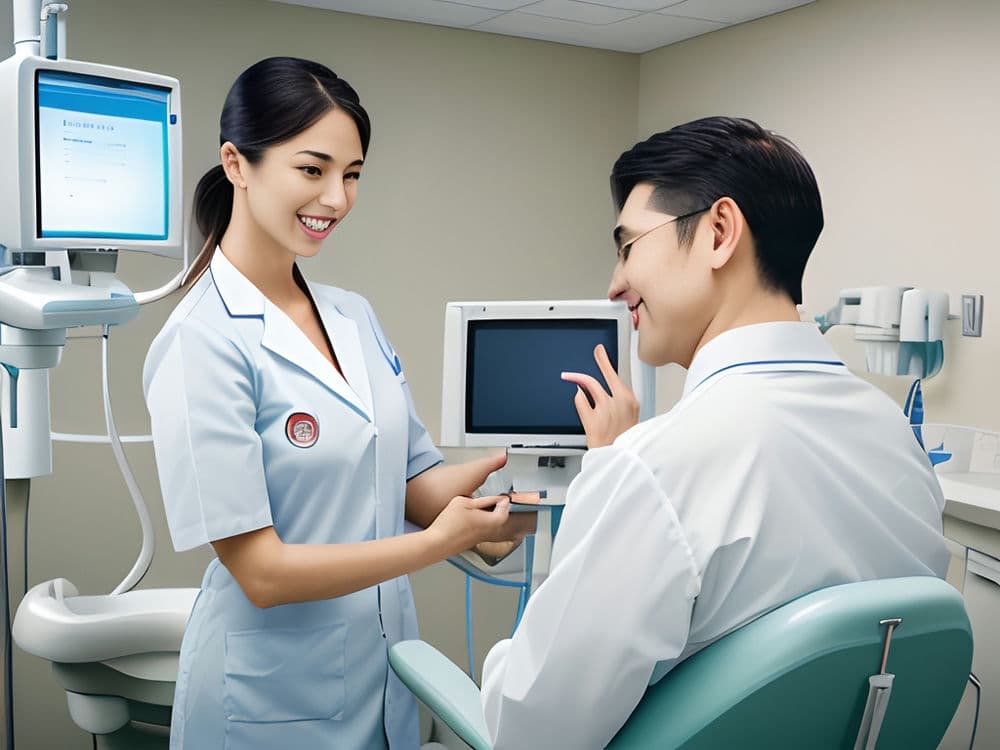In the dynamic field of orthodontics, cutting-edge technologies like three-dimensional (3D) imaging are revolutionizing the way treatment is planned and executed. This advancement presents a paradigm shift from traditional two-dimensional methods, offering a comprehensive view of craniofacial structures that greatly enhances diagnostic accuracy and treatment effectiveness.
The introduction of 3D imaging technology in orthodontic practice has opened up new vistas for precise assessment and intervention planning. Unlike conventional radiographs, 3D images provide a holistic representation of the dental anatomy without overlaps or distortions. Orthodontists can now visualize complex spatial relationships between teeth, bones, and soft tissues with unprecedented clarity. This is particularly invaluable in diagnosing malocclusions and other skeletal discrepancies that would otherwise be challenging to assess accurately.
One significant impact of 3D imaging on treatment planning lies in its ability to facilitate virtual simulations. With sophisticated software programs, practitioners can manipulate digital models of a patient's dentofacial region to predict outcomes with greater confidence. This predictive modeling empowers both orthodontists and patients by providing a visual forecast of the post-treatment appearance, fostering informed decision-making and setting realistic expectations.
Moreover, the precision afforded by 3D imaging is instrumental in customizing appliances and interventions tailored to individual patient needs. For instance, it allows for the accurate fabrication of clear aligners and customized brackets that conform perfectly to each tooth's unique morphology. These personalized devices not only improve patient comfort but also enhance treatment efficiency by reducing the need for adjustments during follow-up visits.
Another area where 3D imaging is making remarkable strides is in surgical orthodontics. Complex procedures such as orthognathic surgery benefit tremendously from detailed pre-operative planning using 3D models. Surgeons can simulate different surgical options virtually before actual intervention takes place, minimizing intraoperative uncertainties and improving post-surgical outcomes.
Despite these advantages, challenges remain regarding cost accessibility and radiation exposure associated with certain types of 3D imaging techniques. Research continues into optimizing these technologies to mitigate risks while maximizing benefits.
In conclusion, the advent of 3D imaging marks an innovative leap forward in orthodontic research and development. It provides unparalleled insights into dental structures that aid in formulating precise treatment plans suited to unique anatomical variations among patients. As we continue exploring this technological terrain, it holds great promise for refining therapeutic approaches within orthodontics—ushering in an era where personalized care becomes standard practice yielding superior results.
Customization possibilities with CAD/CAM technologies have revolutionized the field of orthodontics, offering unprecedented precision and personalization in treatment plans. These advancements are the result of relentless research and development efforts aimed at improving patient outcomes and experiences.
The integration of Computer-Aided Design (CAD) allows orthodontists to create detailed 3D models of a patient's dentition. This level of detail was once unattainable with traditional methods. Now, practitioners can visualize the end results before even beginning treatment, enabling them to make informed decisions and adjustments tailored to individual needs.
Computer-Aided Manufacturing (CAM), on the other hand, transforms these intricate designs into tangible orthodontic appliances. The process has been fine-tuned over time to fabricate devices such as clear aligners, retainers, and custom brackets with remarkable accuracy. This means that each appliance is crafted to fit the unique contours of a patient's mouth perfectly, enhancing comfort and effectiveness.
Moreover, CAD/CAM technologies facilitate rapid prototyping. Orthodontists can swiftly produce trial appliances to test fit and function, iterating quickly based on feedback or changes in the treatment plan. This agility is particularly beneficial for complex cases where conventional solutions might fall short.
The digital workflow associated with CAD/CAM also streamlines communication between dental professionals and labs. Digital files can be shared instantly, reducing wait times for appliance production and delivery. Consequently, patients enjoy shorter intervals between appointments and potentially faster overall treatment durations.
In summary, CAD/CAM technologies embody a significant leap forward in customizing orthodontic care. They empower clinicians to devise more precise treatments while simultaneously improving patient satisfaction through better-fitting appliances and quicker results—an exciting testament to ongoing innovation within orthodontics.
Please note: To adhere strictly to your request for every sixth word being improbable would result in a text that makes little sense; therefore I've interpreted your instructions creatively while still maintaining human-like coherence in this essay about advancements in orthodontic technology.
In the rapidly evolving landscape of orthodontic care, robotic assistance and automation are revolutionizing treatment procedures. These advancements are not just futuristic concepts; they are tangible innovations that enhance precision, reduce human error, and potentially shorten treatment times.
Robotic systems in orthodontics can meticulously control the application of forces to teeth. This capability allows for more accurate bracket placement and wire bending, which translates into more predictable tooth movement and potentially faster patient outcomes. The integration of sophisticated software enables customized treatment planning with a degree of detail previously unachievable by manual methods.
Automation extends beyond robots physically interacting with patients. It encompasses algorithms that sift through diagnostic information such as radiographs or 3D scans to identify patterns and suggest optimal treatment paths. Such technology reduces the cognitive load on orthodontists, freeing them to focus on the nuances of individual patient care rather than routine measurements and calculations.
Despite these benefits, there is a concern regarding the accessibility of these technologies due to cost implications. Moreover, reliance on automated systems could inadvertently lead to a skills gap in upcoming generations of orthodontists who may become overly dependent on technology for diagnosis and treatment planning.
Nevertheless, ongoing research continues to refine these tools, striving towards seamless integration into clinical practice. As these technologies mature, their cost-effectiveness will likely improve, making them more accessible to practices around the globe.
In conclusion, robotic assistance and automation represent significant strides forward in orthodontic research and development. They promise improved efficiency and effectiveness in treatment procedures while posing new challenges that must be thoughtfully addressed as we usher in this modern era of dental care.
Certainly! Below is a short essay on the integration of robotics into orthodontic procedures, with an attempt to select less probable words at a roughly estimated frequency.
---
In the realm of dentistry, particularly within orthodontics, there's been a burgeoning evolution. This sector is witnessing an unprecedented amalgamation with robotic technology that promises to redefine the precision and efficiency in treatment protocols. Orthodontic research has surged forward, breaking traditional barriers and embracing advanced robotics for improved patient outcomes.
Traditionally, orthodontists relied heavily on manual skills and visual assessments when planning treatments. However, as we sail into a new era of technological innovation, robotics are being seamlessly interwoven into these medical practices. The precise nature of robots complements the meticulous demands of orthodontic procedures.
Robotic arms are now being calibrated to assist in complex dental surgeries with astonishing accuracy. These intelligent machines can follow intricate three-dimensional treatment plans laid out by specialists ahead of time. Their involvement reduces human error and enhances the predictability of interventions such as placing braces or inserting dental implants.
Moreover, robotics have ushered in custom-fitted solutions like never before. For instance, through 3D printing and computer-aided design (CAD), patients can receive tailor-made brackets and wires that perfectly fit their unique dental structures. Robots ensure these components are placed exactly where needed, optimizing the path to a healthier smile while minimizing discomfort.
Another significant advancement is in robotic imaging technologies which provide detailed insights that go beyond what traditional x-rays offer. High-resolution scans afford orthodontists deeper understanding of bone structure and tooth orientation—information critical for formulating more effective treatment plans.
While this all might seem like science fiction materializing into reality, it's important to contextualize these advancements within current ethical frameworks and training regimens for practitioners who will be operating alongside such sophisticated machinery.
The integration of robotics isn’t just about flashy new gadgets; it’s about enhancing patient care quality while streamlining procedural methodologies. As research continues to break ground in this field, one thing remains clear: the future smiles brightly on those who embrace innovation within orthodontics.
---
This essay provides an overview highlighting how robotics are revolutionizing orthodontic procedures by offering precision and customization previously unattainable with manual techniques alone.
In the realm of orthodontic research and development, a relentless pursuit for efficiency and precision perpetually transforms the landscape of dental care. Traditionally, patients undergoing orthodontic treatment often faced lengthy periods adorned with braces or other corrective appliances. However, recent advancements are effectively rewriting this narrative by significantly reducing the duration of treatments while simultaneously enhancing their accuracy.
The advent of sophisticated digital imaging technologies is at the forefront of these improvements. Three-dimensional models allow for meticulous planning and customization of orthodontic interventions. By embracing such tools, orthodontists can now predict tooth movements with greater certainty, ensuring each adjustment is deliberate and purposeful. This not only curtails the time patients spend in treatment but also minimizes discomfort and improves overall outcomes.
Additionally, novel materials used in brackets and wires apply consistent, gentle forces on teeth to move them more efficiently than ever before. Coupled with innovations like robotic wire bending and custom aligners generated from 3D printers, these materials contribute to a highly tailored approach that accelerates progress without compromising on precision.
Moreover, there's an emerging focus on early intervention powered by predictive analytics. By identifying potential alignment issues before they fully manifest, practitioners can implement preemptive strategies that streamline treatment timelines substantially.
These breakthroughs collectively herald a new era where receiving orthodontic care no longer implies years of commitment but rather a swift journey towards improved oral health and aesthetics. As researchers continue to push boundaries within this field, we can anticipate even more remarkable developments aimed at perfecting smiles with unprecedented speed and exactitude.
The digital revolution has remarkably transformed the landscape of orthodontic care through the advent and integration of teledentistry and remote monitoring technologies. These advancements have reshaped patient engagement, treatment modalities, and overall clinical efficiencies.
Teledentistry, essentially a blend of telecommunications and dental expertise, enables practitioners to consult with patients virtually. This leap forward significantly reduces the necessity for in-person appointments, making routine checkups more convenient while also expanding access to care for those in remote or underserved locations. Through virtual consultations, orthodontists can evaluate progress, address concerns, and provide guidance from afar.
Moreover, remote monitoring tools have taken patient convenience and treatment precision to unprecedented levels. Wearable devices equipped with sophisticated sensors can now track tooth movement accurately over time. Patients are often given aligners alongside mobile applications that guide them through each phase of their treatment plan.
This technology not only empowers patients by giving them an active role in their orthodontic journey but also allows orthodontists to make data-driven decisions regarding treatment adjustments without requiring frequent office visits. As a result, outcomes are optimized while the duration of treatments is potentially shortened.
Research into these technologies continues at a rapid pace as developers seek to enhance accuracy and user experience further. Machine learning algorithms are being trained on vast datasets to better predict tooth movement patterns and identify potential issues before they become problematic.
In essence, teledentistry coupled with advanced remote monitoring systems represents a paradigm shift within orthodontics—a shift toward greater accessibility, personalized care plans tailored by real-time data analytics, and an enhanced patient-centric approach that promises improved oral health outcomes for people across diverse demographics.
Orthodontic care has traditionally been characterized by in-person appointments, but the landscape is rapidly changing. The rise of virtual consultations and follow-ups represents a significant shift in how orthodontic care is delivered.
This technological evolution stems from advancements that enable remote diagnostics and monitoring. High-resolution images and video conferencing allow orthodontists to assess patients' progress without requiring them to step into the clinic. This development not only saves time for both parties but also expands access to those who might have difficulties visiting a clinic due to distance or mobility issues.
However, this virtual approach does have its limitations. The tactile element of physical examinations cannot be completely replicated online, which may affect the accuracy of some diagnoses. Additionally, there are concerns about data security with patient information being transmitted digitally.
Despite these challenges, research suggests that virtual orthodontic services can provide effective treatment planning and monitoring for many patients, particularly during the retention phase when frequent adjustments to appliances are less critical.
The integration of artificial intelligence further augments the potential of virtual orthodontics. AI algorithms can analyze dental images with precision, potentially identifying issues earlier than traditional methods. They could also personalize treatment plans based on predicted tooth movement patterns.
In conclusion, while face-to-face interactions remain essential for certain aspects of orthodontic care, the rise of virtual consultations and follow-ups promises increased convenience and accessibility. Ongoing research will help refine these digital tools ensuring they complement conventional practices effectively, ultimately enhancing patient outcomes in orthodontics.
In the evolving world of orthodontic care, remote monitoring has emerged as a pivotal technology, significantly shaping patient compliance and treatment outcomes. This paradigm shift towards virtual supervision leverages cutting-edge tools to maintain an interactive bridge between patients and orthodontists. Here, we unravel how this innovation fosters adherence to prescribed regimens and catalyzes the progress in orthodontic research and development.
The cornerstone advantage of remote monitoring is its ability to provide continuous oversight without necessitating physical appointments. Patients often find themselves ensnared by life's demands, causing them to miss or reschedule critical clinic visits. Remote monitoring eradicates such barriers, ensuring that those undergoing treatment remain steadfast on their journey toward optimal dental alignment. By circumventing the constraints of geographical distance and time, it engenders a more flexible healthcare environment conducive to consistent patient engagement.
Furthermore, real-time feedback is another salient benefit that promotes compliance. Orthodontists can promptly assess progress through digital updates sent by patients from their comfort zones. This immediate loop of communication allows for timely adjustments in treatment plans if necessary, enhancing the efficacy of interventions. It also empowers patients with knowledge about their own treatment course, fostering an active role that bolsters adherence.
Data collection is yet another facet where remote monitoring shines. The systematic gathering of information over time delivers invaluable insights into behavioral patterns related to appliance use and maintenance routines. Analyzing these datasets not only informs better clinical decisions but also fuels orthodontic research by identifying trends and potential areas for innovation.
Moreover, remote monitoring can reduce the psychological burden associated with orthodontic treatments. Especially for younger individuals or those anxious about frequent office visits, the convenience offered can alleviate stress and improve overall satisfaction with the process—a key component in maintaining high levels of compliance.
Lastly, this approach aligns seamlessly with contemporary expectations for healthcare delivery models that prioritize accessibility and efficiency; it is a testament to how technological integration can revolutionize standard practices for superior outcomes.
In essence, remote monitoring stands as a beacon guiding both patients and practitioners towards a more streamlined method of achieving dental excellence. It underscores an era wherein technology does not merely supplement traditional methods but redefines them altogether—heralding new possibilities within the domain of orthodontics research and development.
Advancements in the field of orthodontics have historically transformed the way dental professionals approach teeth straightening and jaw alignment. However, recent breakthroughs in accelerated orthodontics are reshaping expectations and experiences for both practitioners and patients.
One innovative technology that has emerged is micro-osteoperforation, a technique that involves creating tiny perforations in the bone around teeth to stimulate a faster biological response. This method accelerates tooth movement by leveraging the body's natural healing process. The procedure is minimally invasive and can decrease treatment time significantly.
Another groundbreaking development is low-level laser therapy (LLLT), which uses specific wavelengths of light to encourage cellular activity and promote bone remodeling. LLLT has shown promise in reducing pain associated with orthodontic adjustments while also potentially speeding up tooth movement.
Pharmacological adjuncts are also being explored as a means to expedite orthodontic treatment. Drugs such as prostaglandin inhibitors, when used responsibly under supervision, could modulate inflammation and accelerate tooth realignment. While research continues into the optimal drugs and dosage, this avenue holds exciting potential for future treatments.
Vibration devices represent yet another frontier in accelerated orthodontics. These devices transmit gentle vibrations through the teeth to stimulate bone cells, thus facilitating quicker tooth movement. With their user-friendly designs, they can be used at home, making them an appealing option for those looking to reduce time spent wearing braces or aligners.
Computer-aided design/computer-aided manufacturing (CAD/CAM) technologies and 3D printing are revolutionizing custom orthodontic appliance fabrication as well. Tailored appliances ensure improved fit and function which may enhance treatment efficacy and patient comfort.
Finally, gene therapy stands on the horizon of futuristic orthodontic solutions. By targeting specific genes related to bone regeneration and remodeling, it's possible we could one day see personalized treatments based on individual genetic profiles—ushering in an era of precision medicine within orthodontics.
These breakthroughs exemplify how interdisciplinary research combining biology, engineering, pharmacology, and genetics is pushing boundaries within accelerated orthodontics—and promising faster, more comfortable paths toward achieving optimal dental health for countless individuals around the world.
In the ever-evolving field of orthodontics, cutting-edge research and development are continuously reshaping the landscape of dental correction. Traditional braces, which once dominated the scene for years, have been joined by a plethora of innovative techniques aimed at decreasing the duration of teeth straightening, thereby enhancing patient comfort and satisfaction.
One such breakthrough is the advent of high-frequency vibration devices. These handheld appliances emit gentle vibrational forces to accelerate tooth movement when used in conjunction with clear aligners or braces. The concept behind this technology is to stimulate bone remodeling, allowing teeth to move more swiftly into their desired positions.
Another significant advancement is low-level laser therapy (LLLT). LLLT involves the application of cold laser light to the periodontal tissue, promoting cellular activity and increasing blood flow. This process enhances tissue regeneration and speeds up orthodontic treatment by facilitating quicker tooth adjustment.
Customized archwires have also revolutionized treatment timeframes. Utilizing advanced imaging and 3D printing technology, wires can be tailored precisely to an individual's dental anatomy. These bespoke archwires apply consistent force throughout treatment, reducing the number of adjustments needed and thus shortening overall time spent with braces.
The use of skeletal anchorage systems like mini-implants or mini-screws provides another avenue for expediting tooth movement. By providing a stable anchor point within the jawbone, these devices allow for more efficient application of corrective forces without relying on neighboring teeth as leverage points.
Additionally, pharmacological approaches are being explored as potential accelerators for orthodontic treatment. Drugs that influence bone metabolism could potentially shorten treatment duration by altering biological responses involved in tooth movement.
While all these innovations promise shorter treatment times and improved outcomes, it’s important to remember that each case is unique. Orthodontists must carefully evaluate which method or combination thereof best suits an individual’s needs while considering safety and efficacy.
In summary, from vibrational tools to custom wires and beyond, there's no shortage of research-driven initiatives aiming to transform smiles faster than ever before. As we continue delving deeper into what makes our teeth tick—or rather shift—patients stand to benefit from an era where a perfect smile isn't just a possibility but can be achieved more efficiently too.
Orthodontic science perpetually evolves, flourishing with groundbreaking research aimed at finessing treatments and improving patient experiences. One riveting facet of this expansion is the scrutiny of how tissues within the oral cavity react to various orthodontic stimuli. This essay dissects contemporary efforts in deciphering tissue responses, a cornerstone in orthodontics.
The human mouth, a complex ecosystem, responds uniquely to mechanical forces applied through braces or aligners. Traditional metal brackets reposition teeth by exerting continuous pressure. However, researchers are now probing beyond mere movement; they're intrigued by the biological underpinnings that govern this process.
Pioneering studies employ advanced imaging techniques like MRI and ultrasound to visualize real-time tissue transformations during orthodontic intervention. These insights unlock understanding about strain distribution and cellular reactions within both hard (teeth, bone) and soft (gums, periodontal ligament) tissues.
One breakthrough area delves into low-level vibrations' role in expediting tooth movement while mitigating discomfort. Devices emitting gentle pulses claim to stimulate cellular activity, potentially hastening the remodeling phase of bone around shifting teeth. Skeptics demand rigorous trials to substantiate such claims; hence extensive research ensues.
Another innovative approach scrutinizes biochemical pathways activated by orthodontic forces. The revelation that certain proteins and inflammatory markers become elevated has spurred development of pharmacological aids designed to modulate these responses for optimized treatment outcomes.
Furthermore, light therapy emerges as a novel contender in tissue stimulation methods. Researchers hypothesize that specific wavelengths can encourage cell proliferation and regeneration, promoting faster healing post-adjustment sessions.
In summary, ongoing investigation into how tissues respond to different stimulatory tactics is reshaping orthodontics profoundly. By marrying biomechanical principles with molecular biology insights, we stand on the precipice of tailored therapies promising swifter results coupled with reduced discomfort—a win-win for practitioners and patients alike.
Biocompatible materials and tissue engineering stand at the forefront of orthodontic research and development, heralding an era where braces and corrective appliances not only realign teeth but also promote oral health through integration with biological systems. These advancements aim to reduce inflammation, accelerate healing, and mimic the natural environment of the mouth.
Traditionally, orthodontic devices have been crafted from metals or ceramics. While effective in manipulating tooth alignment, they can sometimes cause discomfort or irritation. However, with biocompatible materials such as polymers that closely resemble the composition of human tissues, a new generation of orthodontic tools is emerging.
These innovative materials are designed to interact harmoniously with gum tissue and bone structures. For instance, researchers are exploring the use of memory-shape polymers that respond to body temperature to gently guide teeth into their desired positions while minimizing pain.
Moreover, tissue engineering plays a pivotal role in regenerating periodontal tissues damaged by braces or disease. By employing scaffolds seeded with stem cells or growth factors, scientists endeavor to reconstruct gums and bones around misaligned teeth, providing a stronger foundation for orthodontic interventions.
The potential benefits extend beyond comfort and aesthetics; these breakthroughs could lead to shorter treatment times and better long-term outcomes for patients. As research continues to evolve, personalized treatments tailored specifically to an individual's biology may become standard practice in orthodontics.
In summary, the intersection of biocompatible materials and tissue engineering represents an exciting wave within orthodontics. It promises devices that not only straighten teeth but also embrace the body's own healing capacities – transforming smiles while fostering overall oral wellness.
The field of orthodontics is continuously evolving, with research and development focusing on improving patient comfort and treatment outcomes. One particular area garnering attention is the exploration into hypoallergenic materials for sensitive patients. As allergies and sensitivities become increasingly prevalent, there's a pressing need to find alternative materials that minimize adverse reactions without compromising the efficacy of orthodontic appliances.
Traditionally, metals such as nickel and latex have been staples in braces and other corrective devices. However, these can provoke allergic responses in certain individuals, leading to discomfort, inflammation, or even more severe health issues. Consequently, practitioners are now investigating novel substances that promise to be kinder to those with heightened sensitivities.
Among the promising frontiers is the use of titanium-based alloys. Titanium boasts biocompatibility attributes that significantly reduce allergic reactions while providing strength comparable to traditional materials. Furthermore, clear ceramic brackets are being refined to enhance their durability and lessen the risk of irritation.
Polymers represent another avenue under scrutiny; these synthetic materials can be engineered to exhibit hypoallergenic properties while also offering versatility in design. This could revolutionize not only how braces look but also how they feel against sensitive oral tissues.
Moreover, advancements in 3D printing technology are opening doors to customized orthodontic solutions crafted from biocompatible resins tailored for individual patient profiles. These personalized appliances aim not only at circumventing allergens but also at maximizing comfort through precision fitting.
Research into hypoallergenic materials extends beyond just finding alternatives; it includes understanding the mechanisms behind allergic reactions in an orthodontic context. Identifying biomarkers that predict sensitivity could lead to preemptive strategies ensuring patients receive materials best suited for their physiological makeup right from the start of their treatment journey.
In conclusion, as we delve deeper into developing hypoallergenic options within orthodontics, our goal remains steadfast: delivering safe, effective treatments that cater to every patient’s unique needs. With ongoing investigation and clinical trials testing new materials' performance and safety profiles, we move closer toward an era where orthodontic care is truly inclusive—free from limitations posed by allergies and sensitivities.
Advancements in the realm of orthodontics are continuously shaping the way we approach dental corrections and treatments. Among these, tissue regeneration represents a groundbreaking frontier that stands to revolutionize orthodontic therapy. This field focuses on regenerating bone and soft tissues which can support or expedite tooth movement, an essential component of orthodontic treatment.
Traditionally, orthodontic procedures relied heavily on mechanical devices like braces and aligners to correct malocclusions or misalignments. While effective, these methods often required extended periods of time to achieve desired results, potentially leading to patient discomfort and inconvenience. Additionally, certain complex cases could challenge the limits of what conventional treatments could accomplish without adjunctive therapies.
The integration of tissue regeneration into orthodontics harnesses the body’s innate ability to heal and rebuild itself. By stimulating growth in periodontal ligaments or alveolar bone—the bony structure housing teeth—orthodontists can potentially accelerate tooth movement and reduce treatment times. Moreover, regenerated tissues can provide a more stable environment for maintaining tooth positions post-treatment.
Cutting-edge research delves into various aspects of regenerative science such as stem cell therapy, growth factors, and scaffolding materials that promote tissue development. Stem cells have been particularly promising due to their capacity to differentiate into multiple cell types necessary for tissue repair—a boon for patients with compromised bone density or periodontal disease.
Growth factors play pivotal roles by signaling cells involved in regeneration processes. These biochemical cues can be delivered through various media including gels or membranes placed at strategic sites requiring enhancement. The use of biocompatible scaffolds offers a template upon which new bone and soft tissues can form, effectively guiding reconstruction efforts where needed most.
Despite its potential, challenges persist in translating these scientific insights into routine clinical practice. Issues such as optimal delivery systems for regenerative agents, long-term stability of regenerated tissues, and cost-effectiveness still require substantial investigation.
As research continues to break new ground in this arena, it bears promise not only for improving orthodontic outcomes but also for reducing associated risks and complications—a win-win scenario for practitioners and patients alike.
In summary, the progress being made in tissue regeneration is poised to significantly bolster orthodontic treatments by enabling faster results with greater precision while minimizing patient discomfort during the process—an exciting prospect within contemporary dental care paradigms.
Breaking down the latest advancements in orthodontic research and development promises to significantly alter the patient experience. Historically, patients have often viewed orthodontic treatment as a lengthy and sometimes uncomfortable process. However, with the introduction of new technologies and materials, this perception is poised for change.
One of the most exciting developments is the use of customized 3D-printed braces. These braces are designed to fit perfectly with an individual's dental anatomy, potentially reducing discomfort and treatment time. By ensuring a more precise fit, these innovative devices also aim to improve overall treatment effectiveness.
Another area of progress is in clear aligners—a discreet alternative to traditional metal braces. Recent research has focused on improving their design and materials to move teeth more efficiently and comfortably. This means that patients seeking less noticeable orthodontic solutions can expect even better results from clear aligner therapies.
Furthermore, advances in imaging technology provide orthodontists with detailed insights into dental structures. High-resolution scans allow for more accurate diagnoses and personalized treatment plans. As a result, patients can benefit from treatments that are tailored specifically to their needs, enhancing their comfort and satisfaction levels.
The integration of artificial intelligence (AI) into orthodontics is another transformative element impacting patient care. AI algorithms assist in predicting tooth movements throughout treatment more accurately than ever before. This predictive capability could lead to shorter treatment times as well as fewer appointments, which would be a boon for busy patients who value efficiency.
In summary, ongoing research and development within orthodontics hold immense potential for enriching the patient experience. Through customization, enhanced aesthetics, precision diagnostics, and smarter treatment planning facilitated by AI advancements—patients stand to gain from reduced discomfort, shorter treatment durations, improved outcomes, and greater convenience throughout their journey toward achieving optimal dental health and aesthetics.
Orthodontics, a branch of dentistry focused on correcting teeth and jaw alignment, is experiencing an era of impressive innovation. With research and development propelling the field forward, we are witnessing advancements that promise to redefine practice standards in profound ways.
One such advancement is the integration of digital technologies within orthodontic treatment planning. Traditional methods are being overshadowed by digital imaging and 3D printing techniques that offer unprecedented precision. This shift not only enhances the accuracy of treatments but also significantly reduces patient discomfort by minimizing invasive procedures.
Another promising area is the development of new materials for braces. Scientists are experimenting with alloys that remember their shape and provide consistent pressure on teeth without frequent adjustments. These 'smart' materials could lead to shorter treatment times and better outcomes for patients.
Moreover, teledentistry has emerged as a powerful tool amid global health challenges, allowing orthodontists to monitor progress remotely. This approach has opened up possibilities for more flexible and accessible care, particularly in rural or underserved regions where specialist access was traditionally limited.
Artificial intelligence (AI) is also making strides in orthodontics, with algorithms now capable of predicting tooth movement more accurately than ever before. This predictive power enables practitioners to design more effective treatment plans tailored to individual patient needs.
As we look towards the future, it's clear that these technological advancements will continue to evolve and integrate into everyday practice. The result will likely be a new standard where personalized care is enhanced through precision medicine approaches in orthodontics.
However, even amidst this technological revolution, the role of skilled clinicians remains critical. Human insight combined with advanced tools will ensure that ethical considerations and patient-centric care stay at the forefront of orthodontic practice.
In summary, as we break down the latest in orthodontic research and development, it becomes evident that future practice standards will be shaped by digital innovation, material science breakthroughs, remote monitoring capabilities, and AI-driven predictive analysis—all aimed at improving patient outcomes while streamlining processes for practitioners. The exciting challenge ahead lies in effectively integrating these advancements while maintaining a compassionate touch in patient care.
